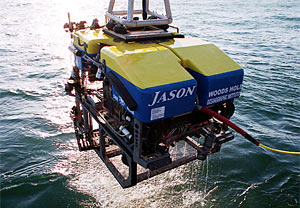Remotely Operated Vehicles (ROVs)
ROVs are unmanned vessels that give scientists the opportunity to study and collect organisms from greater depths than manned submersibles, without the risk to human life, and at less expense and effort. ROVs are becoming the primary tool for studying the biodiversity of the deepest oceanic ecosystems and are a key technology in Census research. They are linked to a surface support research vessel that controls their underwater activity and transports them to and from the research site.

The French ROV, VICTOR, with numerous oceanographic instruments. (Census of the Diversity of Abyssal Marine Life - CeDAMar. IFREMER)

The English ROV, ISIS, being launched off the back of a research vessel. (Dave Edge, Southampton Oceanography Centre)

Pilots and scientists direct the ROV ISIS from the control room onboard a research vessel. (Biogeography of Deep-Water Chemosynthetic Ecosystems Project - ChEss. H. Luppi)

ROV Jason has served in surveying and exploring hydrothermal vents, the wreck of RMS Titanic, and a 1,600-year-old Roman trading ship. (Woods Hole Oceanographic Institution, WHOI)

